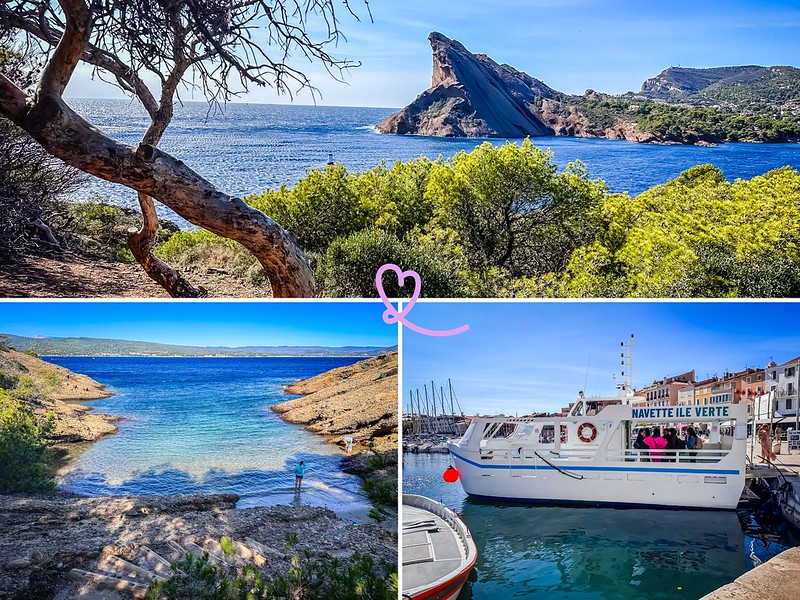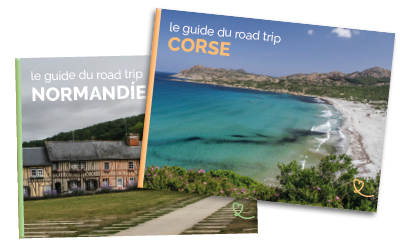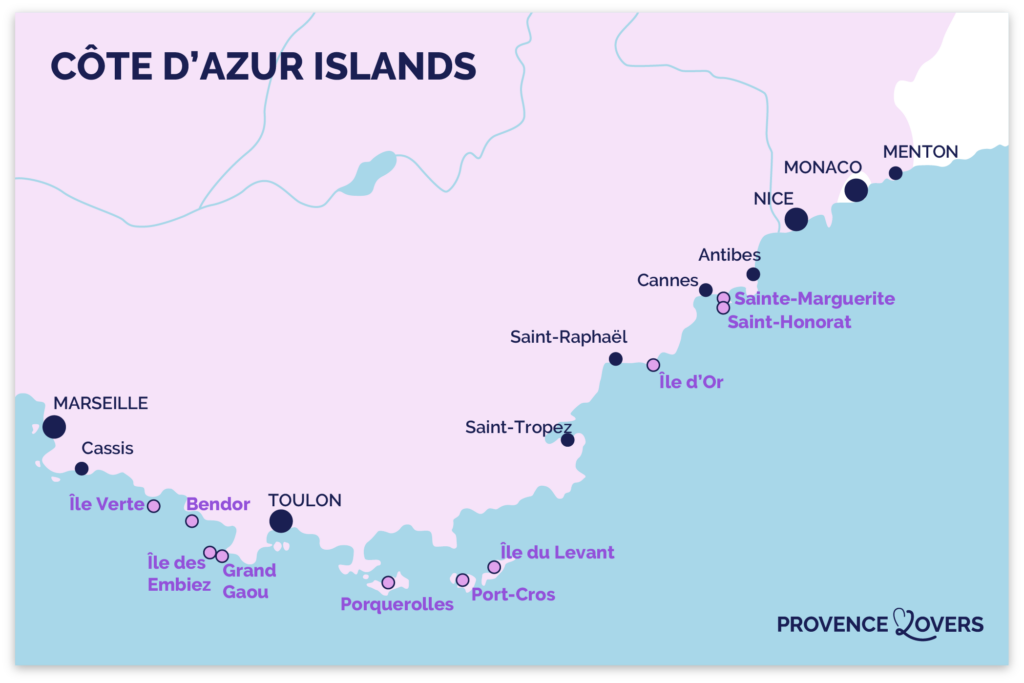If you’re looking for a little nature break during your trip to the Côte d’Azur, we recommend Île-verte. This small island, just a few minutes from La Ciotat’s Old Port, is wooded and offers splendid views over the bay. Here you can hike, swim or simply relax on the beach.
Here’s our guide to visiting La Ciotat’s Île-Verte: how to get there by shuttle bus, nature and historical sites to see, and practical tips for getting ready.

This guide is completely independent, based on our experiences. We visited the region anonymously, making our own choices and paying our bills in full.
Things to do on Île-Verte: map + essentials for your visit

If you’re planning a visit to Île-Verte, here’s what you need to know:
- The boat trip lasts 15min
- Tickets must be purchased on the boat – see timetables here
- Allow 45min to 1h to walk around the island – path under the trees with some fairly steep slopes
- The three small beaches are: Calanque La Plageaolle, Calanque St-Pierre and Calanque Seynerolles. In our opinion, the most beautiful is Calanque Seynerolles.
- You can also discover the island’s coastline by kayaking from La Ciotat – see program and availability.
In our opinion, visiting Île-Verte is one of the best things to do in La Ciotat. And it’s one of the most beautiful islands on the Côte d’Azur.

1. Enjoy the boat trip
Even before you arrive on the island, you’ll enjoy the experience.
We really enjoyed the shuttle crossing. The boat trip is short, but the scenery is varied.
It starts with the exit from the old port, with magnificent views of the Notre-Dame-de-l’Assomption church and the Ciotaden Museum building.
And on the other side, you can take a closer look at the shipyard and its huge yachts under construction.

Once out of the harbor, we loved the views of Cap d’Aigle with its impressive cliffs, and of course the views of Île-Verte itself, which grew larger as we approached.

WHERE TO STAY IN La Ciotat
Option 1: Old port side
Enjoy the charm of the old town, the port and all the restaurants.
We recommend..:
- Best Western Vieux-Port Hotel with rooftop pool – see prices, photos and availability

Option 2: Beach side
With sea views and direct access to beaches. We recommend..:
- Aparthotel A Deux Pas de L’Eau – see prices, photos and availability
- Hotel Rose Thé – prices, pictures and availability

2. Plage Saint-Pierre and Restaurant (at the pontoon)
When the boat arrives on the island, the descent is made onto a pontoon at Calanque Saint-Pierre.
Here you’ll find a pebble beach and the island’s only functional building: Restaurant L’Île-Verte.
It’s a pleasant place with beautiful views. They serve locally caught fish and some meat dishes.

However, if you want to enjoy even more beautiful views, and more peace and quiet. Climb the stairs opposite to explore the island.

3. Plageolle cove
Once at the top of the stairs, we headed off to the right and the Plageolle cove.
There are signs along the way to help you find your way. In our opinion, it’s a two-way street. We have no preference.
Turning right, our first stop was the small Calanque La Plageaolle. It deserves its name because it’s so small.
As everywhere on the Côte d’Azur beaches, the colors are magnificent.
We preferred to walk around the island rather than go for a swim, but in our opinion, it’s definitely one of La Ciotat’s most beautiful beaches.

4. Hike and enjoy the views
So we resumed our hike. The advantage is that there are lots of trees, and you don’t have to walk in direct sunlight. Not a common occurrence on the Côte d’Azur. In fact, it’s the only wooded island in the department.
The southeast coast was our favorite section of the walk, with magnificent views of the rock formations of Cap d’Aigle, its red colors and strange shapes.
On several occasions, there are clearings between the trees to enjoy the panorama.

5. Fort Saint-Pierre
Next, the path leads to the first historic buildings: Fort Saint-Pierre. It was built in 1705 by Marshal de Tourville to take advantage of the island’s strategic position. This allows us to control the sea route between Marseille and Toulon.
During the First and Second World Wars, German troops also occupied the site, carrying out extensive work to install artillery and housing.
On August 12, 1944, a bombing raid destroyed the structure. Code name: STP MAL 044.

A LITTLE MORE patience
All the photos, maps, information, good addresses to make your stay in Provence a success, will soon be gathered in a single ebook!
If you wish to be informed of the publication of our guide on Provence, subscribe:

6. Orientation table
Next to the fort is a platform with an orientation table. Don’t miss it.
You can see the whole bay of La Ciotat, starting with Cap de l’Aigle. It’s always nice to have such a 360° panorama (with the sea behind). We could have spent quite some time observing, but we wanted to catch the next ferry back, so we continued on our way.

7. Grande-Calanque
The next point of interest is on the south-west coast: Grande-Calanque.
It’s impossible to get down here, so we have to make do with several views from above. But it’s one of the places where you can best appreciate the island’s geology. Like Cap d’Aigle, the island is made up of rock known as La Poudingue (a conglomerate of sediments).

8. Fort Gery
Right next to Grande-Clanque, you’ll find another fort.
History has it that on September 3, 1808, the English managed to enter La Ciotat’s harbor, demonstrating its vulnerability. The Model Tower was built in 1811. It was never completed, but its strategic location, visible from the sea, was more or less enough to worry enemies.
Construction was completed in 1852 and the name was changed to Tour Géry.
In 1943, the Germans moved in and turned the tower into a command post. They reduced it and added a reinforced concrete roof. But the Americans bombed it on August 13, 1944, sending the Germans fleeing.

9. Isserot cove
The path then leads to another cove which cannot be entered. In our opinion, it’s the most beautiful to admire.
We loved its long shape and the beautiful rocks and colors all around.

10. Calanque Seynerolles
And finally, our last stop before returning to the pontoon is the Seynerolles cove.
You can start by admiring it from above.
But a staircase gives access to the water level, and therefore to swimming!

The beach is a mixture of rocks, pebbles and sand (and also Posidonia meadows at times, essential for beach formation).
It’s a pretty calanque beach, ideal for swimming and snorkeling. If you have young children, the start of the beach is very gently sloping.
In our opinion, this is one of La Ciotat’s most beautiful beaches.

And back to the Pontoon
There’s another 5-10min walk to the pontoon, where you can still enjoy some fine views.
In high season, the shuttle runs every hour to and from the island, so it’s possible to circumnavigate the island between two shuttles, if you’re not swimming.

Frequently asked questions and practical advice
Where to find Île-Verte
- West of the Côte d’Azur
- Off the coast of La Ciotat
- Between Marseille and Toulon
- Marseille to La Ciotat = 40 min drive
- You’ll find the island on the left of the map below:

Is Île-Verte worth a visit?
Yes, Île-verte is well worth a visit.
It’s a pretty little jewel of nature with beautiful views and a rich history.
It’s easy to get to and offers a moment of peace and quiet under the trees, far from the hustle and bustle of the Côte d’Azur.
It is located in the town of La Ciotat, which is less touristy than its cars. For us, it’s one of the lesser-known gems of the Côte d’Azur.
How to get there
From La Ciotat’s old port, the shuttle makes a regular round trip during the season. 15 min each way. See timetable.
Best time to visit
At the height of summer, it can get very crowded. We recommend you take one of the first boats in the morning.
Out of season, it’s fairly quiet and you can enjoy it all day long.

How long and how difficult is the hike?
It takes less than 1 hour to walk around the island if you don’t go swimming.
Take good walking shoes. The soil is a mixture of earth, pebbles and tree roots.
The hike is not flat. There’s a bit of a climb. But the path is well signposted with blue signs (lines indicate the way, crosses indicate not to go that way).

History of Île-Verte
Ceramic remains indicate a human presence since the Neolithic period (-5000 to -4000 BC).
In ancient times, the bay of La Ciotat was an important maritime hub, so there was a lot of traffic around the island.
In the Middle Ages and until the 17th century, the island was used as a hunting ground, among other things.
Then, from the Napoleonic Empire onwards, its strategic position attracted the military. It served as protection against the English and then as a strategic position for the Germans during the Second World War.
Vegetation on Île-Verte
This is a hostile environment, with the incisive sweep of sea spray and the severe drought in summer. This is where you’ll find plants that survive on little and shallow soil: rosemary, microphylls…
PLAN YOUR STAY IN La Ciotat
- Things to do in La Ciotat
- Best hotels to stay in La Ciotat
- Best restaurants (coming soon)
- La Ciotat’s most beautiful beaches
- Tour de l’Île-Verte (coming soon)
- Calanques de Figuerolles


